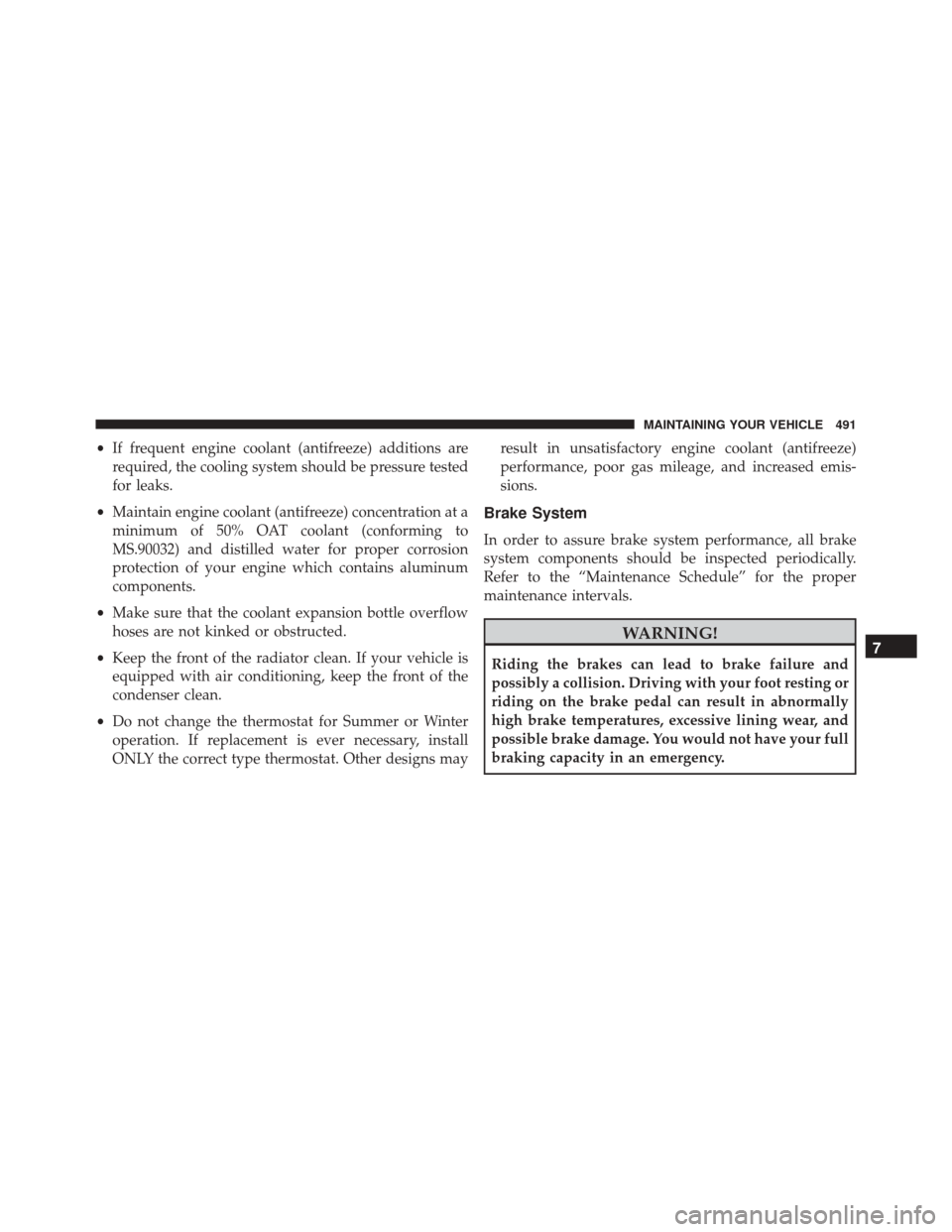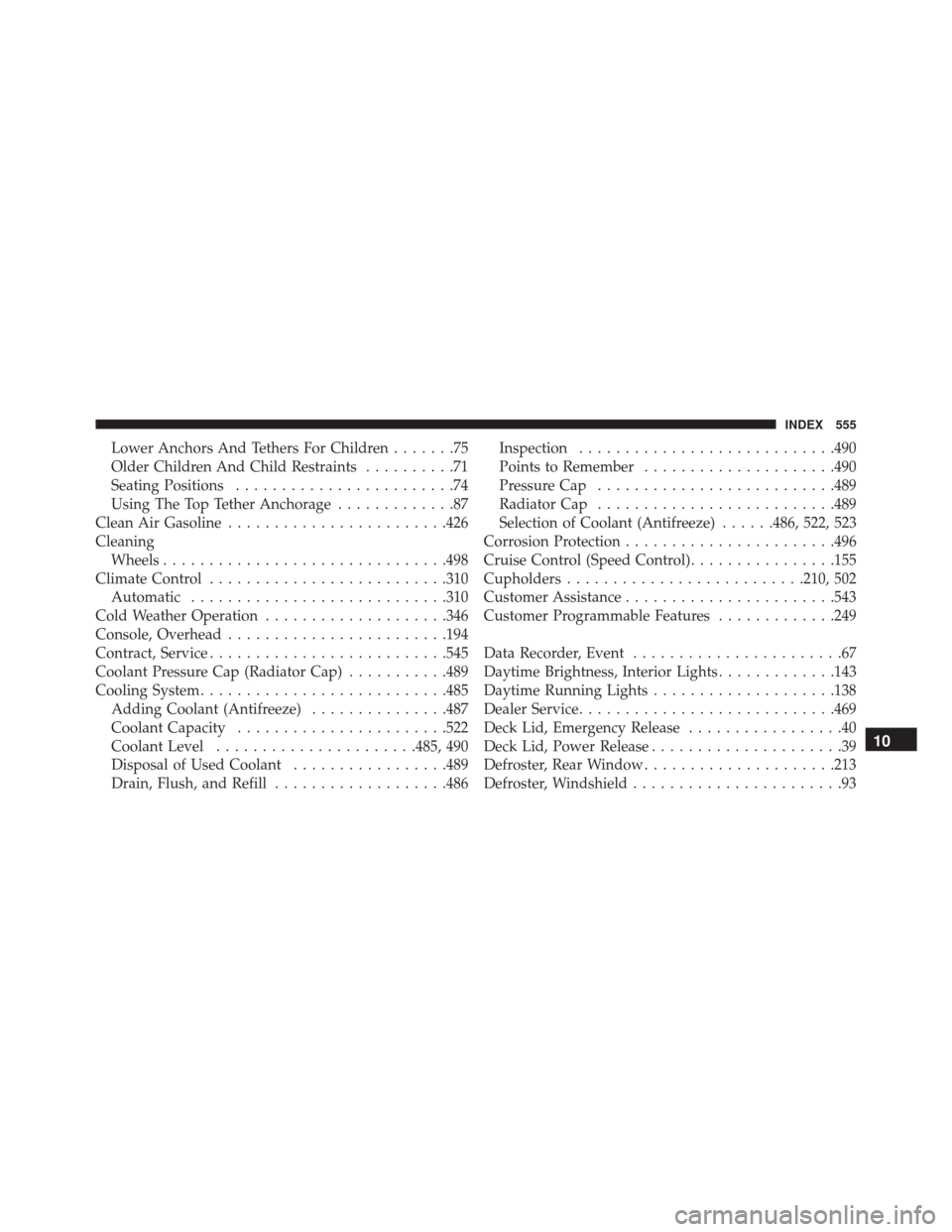2015 DODGE CHALLENGER SRT radiator cap
[x] Cancel search: radiator capPage 441 of 575

to high. This allows the heater core to act as a
supplement to the radiator and aids in removing heat
from the engine cooling system.
CAUTION!
Driving with a hot cooling system could damage
your vehicle. If the temperature gauge reads 240°F
(116°C) or greater pull over and stop the vehicle. Idle
the vehicle with the air conditioner turned off until
the pointer drops back into the normal range 200–
230°F (93–110°C). If the pointer remains at 240°F
(116°C) or greater and you hear a chime, turn the
engine off immediately and call for service.
WARNING!
You or others can be badly burned by hot engine
coolant (antifreeze) or steam from your radiator. If
you see or hear steam coming from under the hood,
do not open the hood until the radiator has had time
to cool. Never try to open a cooling system pressure
cap when the radiator or coolant bottle is hot.
WHEEL AND TIRE TORQUE SPECIFICATIONS
Proper lug nut/bolt torque is very important to ensure
that the wheel is properly mounted to the vehicle. Any
time a wheel has been removed and reinstalled on the
vehicle the lug nuts/bolts should be torqued using a
properly calibrated torque wrench.
6
WHAT TO DO IN EMERGENCIES 439
Page 487 of 575

NOTE:Your vehicles exhaust system may be equipped
with an Electronic Exhaust Valve (EEV) system, if the
exhaust system is replaced with aftermarket products a
Malfunction Indicator Lamp (MIL) may be illuminated.
Cooling System
WARNING!
• When working near the radiator cooling fan,
disconnect the fan motor lead or place the ignition
in the LOCK position (OFF position for Keyless
Enter-N-Go™). The fan is temperature controlled
and can start at any time the ignition switch is in
the ON position (RUN position for Keyless Enter-
N-Go™).
• You or others can be badly burned by hot engine
coolant (antifreeze) or steam from your radiator. If
you see or hear steam coming from under the hood,
(Continued)
WARNING! (Continued)
do not open the hood until the radiator has had
time to cool. Never try to open a cooling system
pressure cap when the radiator is hot.
Coolant Checks
Check the engine coolant (antifreeze) protection every 12
months (before the onset of freezing weather, where
applicable). If the engine coolant (antifreeze) is dirty, the
system should be drained, flushed, and refilled with
fresh OAT coolant (conforming to MS.90032) by an
authorized dealer. Check the front of the A/C condenser
for any accumulation of bugs, leaves, etc. If dirty, clean by
gently spraying water from a garden hose vertically
down the face of the condenser.
Check the coolant recovery bottle and/or the super-
charger coolant recovery bottle (if equipped with the 6.2L
Supercharged engine) tubing for brittle rubber, cracking,
7
MAINTAINING YOUR VEHICLE 485
Page 488 of 575

tears, cuts, and tightness of the connection at the bottle
and radiator. Inspect the entire system for leaks.
With the engine at normal operating temperature (but
not running), check the cooling system pressure cap for
proper vacuum sealing by draining a small amount of
coolant from the radiator drain cock. If the cap is sealing
properly, the engine coolant (antifreeze) will begin to
drain from the coolant recovery bottle. DO NOT RE-
MOVE THE COOLANT PRESSURE CAP WHEN THE
COOLING SYSTEM IS HOT.
Cooling System — Drain, Flush And Refill
NOTE:Some vehicles require special tools to add coolant
properly. Failure to fill these systems properly could lead
to severe internal engine damage. If any coolant is
needed to be added to the system please contact your
local authorized dealer. If the engine coolant (antifreeze) is dirty or contains
visible sediment, have an authorized dealer clean and
flush with OAT coolant (antifreeze) (conforming to
MS.90032).
NOTE:
If equipped with the 6.2L Supercharged engine
the intercooler must be vacuum flushed and filled. If any
coolant is needed to be added to the system please
contact your local authorized dealer.
Refer to the “Maintenance Schedule” for the proper
maintenance intervals.
Selection Of Coolant
Refer to “Fluids, Lubricants, And Genuine Parts” in
“Maintaining Your Vehicle” for further information.
486 MAINTAINING YOUR VEHICLE
Page 491 of 575

Cooling System Pressure Caps
The cap must be fully tightened to prevent loss of engine
coolant (antifreeze), and to ensure that engine coolant
(antifreeze) will return to the radiator from the coolant
recovery tank.
The cap should be inspected and cleaned if there is any
accumulation of foreign material on the sealing surfaces.
NOTE:Be sure you do not mix the engine coolant system
pressure cap with the intercooler system pressure cap
these caps are not interchangeable.
WARNING!
• Do not open hot engine cooling system. Never add
engine coolant (antifreeze) when the engine is
overheated. Do not loosen or remove the cap to cool
an overheated engine. Heat causes pressure to
(Continued)
WARNING! (Continued)
build up in the cooling system. To prevent scalding
or injury, do not remove the pressure cap while the
system is hot or under pressure.
• Do not use a pressure cap other than the one
specified for your vehicle. Personal injury or en-
gine damage may result.
Disposal Of Used Engine Coolant
Used ethylene glycol-based engine coolant (antifreeze) is
a regulated substance requiring proper disposal. Check
with your local authorities to determine the disposal
rules for your community. To prevent ingestion by ani-
mals or children, do not store ethylene glycol-based
engine coolant in open containers or allow it to remain in
puddles on the ground. If ingested by a child or pet, seek
emergency assistance immediately. Clean up any ground
spills immediately.7
MAINTAINING YOUR VEHICLE 489
Page 492 of 575

Coolant Level
The coolant bottle provides a quick visual method for
determining that the coolant level is adequate. With the
engine OFF and cold, the level of the coolant in the bottle
should be between the ranges indicated on the bottle.
The radiator normally remains completely full, so there is
no need to remove the radiator cap unless checking for
coolant freeze point or replacing coolant. Advise your
service attendant of this. As long as the engine operating
temperature is satisfactory, the coolant bottle need only
be checked once a month.
When additional coolant is needed to maintain the
proper level, it should be added to the coolant bottle. Do
not overfill.
Points To Remember
NOTE:When the vehicle is stopped after a few miles/
kilometers of operation, you may observe vapor coming
from the front of the engine compartment. This is nor-
mally a result of moisture from rain, snow, or high
humidity accumulating on the radiator and being vapor-
ized when the thermostat opens, allowing hot engine
coolant (antifreeze) to enter the radiator.
If an examination of your engine compartment shows no
evidence of radiator or hose leaks, the vehicle may be
safely driven. The vapor will soon dissipate.
• Do not overfill the coolant expansion bottle.
• Check the coolant freeze point in the radiator and in
the coolant expansion bottle. If engine coolant (anti-
freeze) needs to be added, the contents of the coolant
expansion bottle must also be protected against freez-
ing.
490 MAINTAINING YOUR VEHICLE
Page 493 of 575

•If frequent engine coolant (antifreeze) additions are
required, the cooling system should be pressure tested
for leaks.
• Maintain engine coolant (antifreeze) concentration at a
minimum of 50% OAT coolant (conforming to
MS.90032) and distilled water for proper corrosion
protection of your engine which contains aluminum
components.
• Make sure that the coolant expansion bottle overflow
hoses are not kinked or obstructed.
• Keep the front of the radiator clean. If your vehicle is
equipped with air conditioning, keep the front of the
condenser clean.
• Do not change the thermostat for Summer or Winter
operation. If replacement is ever necessary, install
ONLY the correct type thermostat. Other designs may result in unsatisfactory engine coolant (antifreeze)
performance, poor gas mileage, and increased emis-
sions.
Brake System
In order to assure brake system performance, all brake
system components should be inspected periodically.
Refer to the “Maintenance Schedule” for the proper
maintenance intervals.
WARNING!
Riding the brakes can lead to brake failure and
possibly a collision. Driving with your foot resting or
riding on the brake pedal can result in abnormally
high brake temperatures, excessive lining wear, and
possible brake damage. You would not have your full
braking capacity in an emergency.
7
MAINTAINING YOUR VEHICLE 491
Page 556 of 575

Anti-Lock (ABS)....................... .386
Fluid Check ....................... .492, 525
Master Cylinder ....................... .492
Parking ............................. .382
Warning Light ..................... .221, 385
Brake/Transmission Interlock .................354
Brightness, Interior Lights ...................142
Bulb Replacement ..................... .516, 519
Bulbs, Light .......................... .95, 516
Camera, Rear ........................... .192
Capacities, Fluid ......................... .522
Caps, Filler Fuel ................................ .430
Oil (Engine) .......................... .472
Radiator (Coolant Pressure) ................489
Carbon Monoxide Warning ................92, 429
Cargo (Vehicle Loading) ....................432
Car Washes ............................ .497Cellular Phone
.......................... .308
Center High Mounted Stop Light ..............521
Certification Label ........................ .432
Chains, Tire ............................ .417
Chart, Tire Sizing ........................ .398
Check Engine Light (Malfunction Indicator Light) . .468
Checking Your Vehicle For Safety ...............91
Checks, Safety ............................91
Child Restraint ............................68
Child Restraints Booster Seats ...........................73
Center Seat LATCH ......................81
Child Restraints .........................68
Child Seat Installation .....................86
How To Stow An Unused ALR Seat Belt ........82
Infants And Child Restraints ................71
Install A LATCH-Compatible Child Restraint ....81
Installing Child Restraints Using The Vehicle Seat
Belt ..................................83
554 INDEX
Page 557 of 575

Lower Anchors And Tethers For Children.......75
Older Children And Child Restraints ..........71
Seating Positions ........................74
Using The Top Tether Anchorage .............87
Clean Air Gasoline ....................... .426
Cleaning Wheels .............................. .498
Climate Control ......................... .310
Automatic ........................... .310
Cold Weather Operation ....................346
Console, Overhead ....................... .194
Contract, Service ......................... .545
Coolant Pressure Cap (Radiator Cap) ...........489
Cooling System .......................... .485
Adding Coolant (Antifreeze) ...............487
Coolant Capacity ...................... .522
Coolant Level ..................... .485, 490
Disposal of Used Coolant .................489
Drain, Flush, and Refill ...................486 Inspection
........................... .490
Points to Remember .....................490
Pressure Cap ......................... .489
Radiator Cap ......................... .489
Selection of Coolant (Antifreeze) ......486, 522, 523
Corrosion Protection ...................... .496
Cruise Control (Speed Control) ................155
Cupholders ......................... .210, 502
Customer Assistance ...................... .543
Customer Programmable Features .............249
Data Recorder, Event .......................67
Daytime Brightness, Interior Lights .............143
Daytime Running Lights ....................138
Dealer Service ........................... .469
Deck Lid, Emergency Release .................40
Deck Lid, Power Release .....................39
Defroster, Rear Window .....................213
Defroster, Windshield .......................93
10
INDEX 555